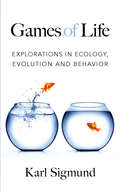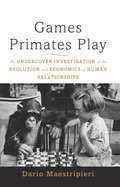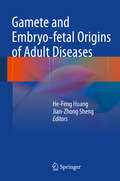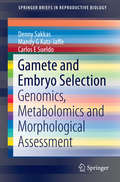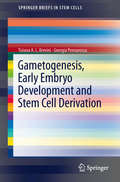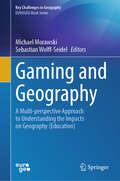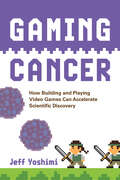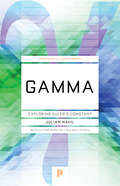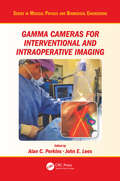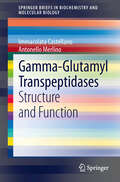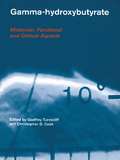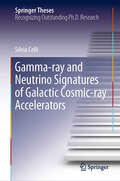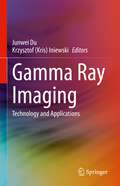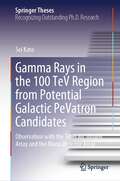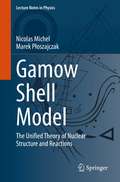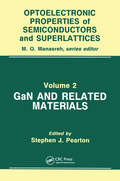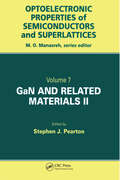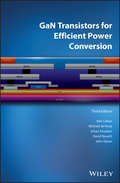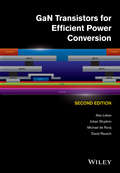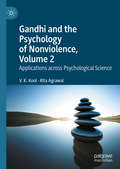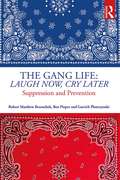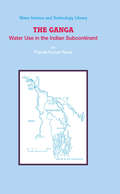- Table View
- List View
Games of Life: Explorations in Ecology, Evolution and Behavior
by Karl Sigmund"A book accessible to all readers, whatever their level of numeracy … an excellent introduction to what theoretical biologists get up to in trying to understand evolutionary and ecological ideas." ― NatureWhy are there only two sexes? Why do stags restrain their aggression in the middle of a fight? Can it ever pay to be nice in a world of selfish individualists? The answers, according to this informative and enjoyable volume, can often be found in games like hide and seek, poker, and the prisoner's dilemma. Author Karl Sigmund applies the ideas and methods of game theory and mathematical modeling to evolution, sex, animal behavior, and aggression in Games of Life, which was included in Ian Stewart's "Top 10 Popular Mathematics Books" in the Guardian (1/18/2012). Starting with artificial life and self-replicating machines, the book examines pursuit games between predators and prey and draws parallels between games of chance and the randomness of molecular evolution. Other topics include the bizarre double games played by chromosomes and applications of game theory to animal behavior. Key topics appear at the start of each chapter, and endnotes provide references for readers wishing to seek out further information. This playful approach to understanding evolution and its central issues of sex, survival, conflict, and cooperation offers a captivating modern perspective on matters of life and death.
Games Primates Play, International Edition: An Undercover Investigation of the Evolution and Economics of Human Relationships
by Dario MaestripieriMost humans don't realize that when they exchange emails with someone, anyone, they are actually exhibiting certain unspoken rules about dominance and hierarchy. The same rules regulate the exchange of grooming behavior in rhesus macaques or chimpanzees. Interestingly, some of the major aspects of human nature have profound commonalities with our ape ancestors: the violence of war, the intensity of love, the need to live together.While we often assume that our behavior in everyday situations reflects our unique personalities, the choices we freely make, or the influences of our environment, we rarely consider that others behave in these situations in almost the exact the same way as we do. In Games Primates Play, primatologist Dario Maestripieri examines the curious unspoken customs that govern our behavior. These patterns and customs appear to be motivated by free will, yet they are so similar from person to person, and across species, that they reveal much more than our selected choices.Games Primates Play uncovers our evolutionary legacy: the subtle codes that govern our behavior are the result of millions of years of evolution, predating the emergence of modern humans. To understand the rules that govern primate games and our social interactions, Maestripieri arms readers with knowledge of the scientific principles that ethologists, psychologists, economists, and other behavioral scientists have discovered in their quest to unravel the complexities of behavior. As he realizes, everything from how we write emails to how we make love is determined by the legacy of our primate roots and the conditions that existed so long ago.An idiosyncratic and witty approach to our deep and complex origins, Games Primates Play reveals the ways in which our primate nature drives so much of our lives.
Games Wizards Play (Young Wizards #10)
by Diane DuaneEvery eleven years, Earth's senior wizards hold the Invitational: an intensive three-week event where the planet's newest, sharpest young wizards show off their best and hottest spells. Wizardly partners Kit Rodriguez and Nita Callahan, and Nita's sister, former wizard-prodigy Dairine Callahan, are drafted in to mentor two brilliant and difficult cases: for Nita and Kit, there’s Penn Shao-Feng, a would-be sun technician with a dangerous new take on managing solar weather; and for Dairine, there's shy young Mehrnaz Farrahi, an Iranian wizard-girl trying to specialize in defusing earthquakes while struggling with a toxic extended wizardly family that demands she perform to their expectations. Together they're plunged into a whirlwind of cutthroat competition and ruthless judging. Penn's egotistical attitude toward his mentors complicates matters as the pair tries to negotiate their burgeoning romance. Meanwhile, Dairine struggles to stabilize her hero-worshipping, insecure protégée against the interference of powerful relatives using her to further their own tangled agendas. When both candidates make it through to the finals stage on the dark side of the Moon, they and their mentors are flung into a final conflict that could change the solar system for the better . . . or damage Earth beyond even wizardly repair.
Gamete and Embryo-fetal Origins of Adult Diseases
by He-Feng Huang Jian-Zhong ShengThe book Gamete and Embryo-fetal Origins of Adult Diseases introduces various diseases resulting from the abnormal gametogenesis and embryo development, which manifests as growth retardation, birth defects, or increased susceptibility to chronic metabolic diseases such as diabetes, cardiovascular disease and cancer in childhood and adult life, even fertility disorders and the risk of transgenerational transmission. Six common kinds of these diseases are discussed in separate chapters. The authors explore the connections between these diseases and epigenetic reprogramming, rapid cell differentiation and organ formation and environmental influences, including assisted reproductive technology and adverse intrauterine environments. With a summary of findings on the causes and progression of adult diseases at the phase of gametogenesis and embryo development, this book provides insights into the pathogenesis of disease and aids in the treatment and prevention of disease, meeting the requirement for improving the quality of the newborn population, and effectively preventing and curing major diseases at an early stage. This book offers new perspectives and will be an enlightening resource for obstetricians, paediatricians, epidemiologists, endocrinologists and sanitarians. Editor He-Feng Huang, M. D. , is Professor and President of Women's Hospital, School of Medicine, Zhejiang University, China. Editor Jian-Zhong Sheng, Ph. D. , is Professor at the Department of Pathology & Pathophysiology, School of Medicine, Zhejiang University, China.
Gamete and Embryo Selection
by Denny Sakkas Mandy G Katz-Jaffe Carlos E SueldoThis book provides the Assisted Reproduction Technologies (ART) community an update of the fast approaching novel technologies that may allow improved assessment of the reproductive potential of sperm, oocytes and embryos The reader has access to concise updates on the rapidly developing diagnostic technologies (genomics, transcriptomics, proteomics and metabolomics) and morphological methods which may help us better assess the gametes and embryos. Methodologies are described which enable selection of the best gamete or embryo by invasive and non-invasive diagnostics, as well as the clinical validity of these techniques.
Gametogenesis, Early Embryo Development and Stem Cell Derivation
by Pennarossa Georgia Tiziana A.L. BreviniThis Brief offers a concise, handy overview of the main concepts related to Embryology, revisited through the novel concepts that are applied daily in stem cell research and cell therapy oriented investigations. It is based on three main areas: -The process involved in female gamete differentiation and maturation. The main aspects related to cell biology will be covered and an overview of the epigenetic regulation of gametogenesis will be presented. -Early stages of embryo development with a careful analysis of the regulatory mechanisms driving cleavage, polarization and genome activation. -Stem cell and gametogenesis. The use of the oocyte as a possible source for the derivation of stem cell lines is discussed and depicted as a powerful tool to investigate oocyte potency and asymmetric imprinting. The potential biological implications are evaluated and use of stem cells to derive oocytes is presented.
Gaming and Geography: A Multi-perspective Approach to Understanding the Impacts on Geography (Education) (Key Challenges in Geography)
by Michael Morawski Sebastian Wolff-SeidelThis book explores the uncharted territory where gaming and geography intersect in "Gaming and Geography (Education)." This book bridges the gap between video games and geography, delving into the constructivist creative processes of game development, gameplay, and critical reflections on video games' role in geographical discourses. Through a multi-perspective lens, the book examines how video games can facilitate the exploration of geographic questions and act as catalysts for critical discourses. Scholars shed light on the geographies presented in video games, including their representations, spatial images, and policies. By viewing video games as cultural and critical geography practices, the authors enrich the political, socio-cultural, and critical geographies associated with this medium. A key argument of the book is that video games can foster systemic competence and networked thinking, particularly in addressing complex socio-ecological challenges like climate change and migration. In contrast to traditional geography classes, digital games provide valuable simulations of complex systems, enhancing students' understanding and skills. The book also explores other possibilities such as digital field trips and language support to enhance the educational experience. "Gaming and Geography (Education)" offers a compelling narrative that highlights the diverse roles video games can play in geographic education. By exploring the intersection of gaming and geography, this book deepens our understanding of this dynamic relationship and its impact on critical geographies within the realm of video games.
Gaming Cancer: How Building and Playing Video Games Can Accelerate Scientific Discovery
by Jeff YoshimiCan experimenting with game design increase our chances of finding a cure for cancer?Cancer is crafty, forcing us to be just as clever in our efforts to outfox it—and we&’ve made excellent progress, but is it time for a new play in the playbook? In Gaming Cancer, Jeff Yoshimi proposes a new approach to fighting an increasingly exhausting war. By putting the work of cancer research into the hands of nonspecialists, Yoshimi believes, we can accelerate the process of outgaming the disease once and for all.Gamers have already used &“serious games&” to discover new galaxies, digitize ancient texts, decode viruses, and solve theoretical problems in neuroscience. Cancer is a multilayered threat, and our best bet at overcoming it is via more minds working in concert. Gaming Cancer is an instruction manual for engineering games that motivate users to strain and sweat to find cancer cures. It integrates game design with research in cancer biology, data visualization techniques, and developments in cognitive science and AI while remaining sensitive to the limitations of citizen science and ethical concerns. Yoshimi sees in cutting-edge game technology the potential to educate and empower people to outwit cancer, an indirect route to richer science literacy that draws on the boundless resources of the mind.This book offers anyone invested in beating this seemingly intractable disease a concrete playbook that combines real science with creative vision in an effort to defeat the boss monster, cancer.
Gamma: Exploring Euler's Constant (Princeton Science Library #53)
by Julian HavilAmong the many constants that appear in mathematics, π, e, and i are the most familiar. Following closely behind is y, or gamma, a constant that arises in many mathematical areas yet maintains a profound sense of mystery. In a tantalizing blend of history and mathematics, Julian Havil takes the reader on a journey through logarithms and the harmonic series, the two defining elements of gamma, toward the first account of gamma's place in mathematics. Introduced by the Swiss mathematician Leonhard Euler (1707-1783), who figures prominently in this book, gamma is defined as the limit of the sum of 1 + 1/2 + 1/3 + . . . Up to 1/n, minus the natural logarithm of n--the numerical value being 0.5772156. . . . But unlike its more celebrated colleagues π and e, the exact nature of gamma remains a mystery--we don't even know if gamma can be expressed as a fraction. Among the numerous topics that arise during this historical odyssey into fundamental mathematical ideas are the Prime Number Theorem and the most important open problem in mathematics today--the Riemann Hypothesis (though no proof of either is offered!). Sure to be popular with not only students and instructors but all math aficionados, Gamma takes us through countries, centuries, lives, and works, unfolding along the way the stories of some remarkable mathematics from some remarkable mathematicians.
Gamma Cameras for Interventional and Intraoperative Imaging (Series in Medical Physics and Biomedical Engineering)
by Alan C. Perkins John E. LeesGamma cameras are traditionally large devices that are situated in nuclear medicine departments, but recent advances in detector design have enabled the production of compact gamma cameras that allow nuclear imaging at the patient bedside and in the operating theatre. Gamma Cameras for Interventional and Intraoperative Imaging is the first book to cover this new area of imaging, and provides a unique insight into the experimental and clinical use of small field of view gamma cameras in hospitals. This book explores advances in the design and operation of compact gamma cameras and conducts a thorough review of current SFOV systems, before exploring the clinical applications of the technology. It is an essential reference for surgeons, operating theatre staff, clinical scientists (medical physicists), technologists, nuclear physicians and radiologists whose patients could benefit from this technology.
Gamma-Glutamyl Transpeptidases: Structure and Function
by Immacolata Castellano Antonello MerlinoGamma-Glutamyl Transpeptidases (γ-GTs) are members of the N-terminal nucleophile hydrolase superfamily, enzymes that cleave the γ-glutamyl amide bond of glutathione to liberate cysteinylglycine. The released γ-glutamyl group can be transferred to water (hydrolysis) or to amino acids or short peptides (transpeptidation). γ-GT plays a key role in the gamma glutamyl cycle by regulating the cellular levels of the antioxidant glutathione, hence it is a critical enzyme in maintaining cellular redox homeostasis.γ-GT is upregulated during inflammation and in several human tumors, and it is involved in many physiological disorders related to oxidative stress, such as Parkinson's disease and diabetes. Furthermore, this enzyme is used as a marker of liver disease and cancer. This book covers current knowledge about the structure-function relationship of γ-GTs and gives information about applications of γ-GTs in different fields ranging from clinical biochemistry to biotechnology and biomedicine.
Gamma-Hydroxybutyrate: Pharmacological and Functional Aspects
by Godfrey Tunnicliff Christopher D. CashGamma-hydroxybutyrate (GHB) has come a long way since early experiments in animals where it was found to induce a sleep-like state and from its use in general anaesthesia in human subjects. It has been found to be a naturally-occurring compound in the brain, a metabolite of GABA, the emerging ubiquitous inhibitory neurotransmitter. This has opened
Gamma-ray and Neutrino Signatures of Galactic Cosmic-ray Accelerators (Springer Theses)
by Silvia CelliThis book addresses three “hot” topics concerning the general problem of the origin of Galactic cosmic rays, namely (1) the acceleration, propagation, and radiation of particles in supernova remnants; (2) very high energy neutrinos from the Galactic Center; and (3) the potential held by the next-generation gamma-ray and neutrino detectors CTA and KM3NeT for studying extended non-thermal sources in the Galaxy. The topics are intrinsically connected to determining the nature (“hadronic or leptonic?”) of gamma-ray emissions from young and middle-aged supernova remnants and the search for cosmic-ray PeVatrons. The results and conclusions provided here are based on extensive analytical and numerical simulations, which are formulated and presented in a straightforward format that can be readily used in the interpretations of gamma-ray and neutrino observations, as well as for confident predictions for future measurements.
Gamma-ray Bursts
by Chryssa Kouveliotou Ralph A. M. J. Wijers Stan WoosleyCosmic gamma ray bursts (GRBs) have fascinated scientists and the public alike since their discovery in the late 1960s. Their story is told here by some of the scientists who participated in their discovery and, after many decades of false starts, solved the problem of their origin. Fourteen chapters by active researchers in the field present a detailed history of the discovery, a comprehensive theoretical description of GRB central engine and emission models, a discussion of GRB host galaxies and a guide to how GRBs can be used as cosmological tools. Observations are grouped into three sets from the satellites CGRO, BeppoSAX and Swift, and followed by a discussion of multi-wavelength observations. This is the first edited volume on GRB astrophysics that presents a fully comprehensive review of the subject. Utilizing the latest research, Gamma Ray Bursts is an essential desktop companion for graduate students and researchers in astrophysics.
Gamma Ray Imaging: Technology and Applications
by Junwei Du Krzysztof Kris IniewskiThis book will provide readers with a good overview of some of the most recent advances in the field of detector technology for gamma-ray imaging, especially as it pertains to new applications. There will be a good mixture of general chapters in both technology and applications in medical imaging and industrial testing. The book will have an in-depth review of the research topics from world-leading specialists in the field. The conversion of the gamma-ray signal into analog/digital value will be covered in some chapters. Some would also provide a review of CMOS chips for gamma-ray image sensors.
Gamma Rays in the 100 TeV Region from Potential Galactic PeVatron Candidates: Observation with the Tibet Air Shower Array and the Muon Detector Array (Springer Theses)
by Sei KatoThis book presents two candidates for astrophysical accelerators of cosmic rays with petaelectron-volt (PeV) energies in our Galaxy, the so-called PeVatrons, through the observation of sub-PeV gamma rays performed by the Tibet air shower array. The two gamma-ray sources are TASG J1844-038—a newly detected source in this presented work—and HESS J1849-000. Reconstructing their gamma-ray energy spectra up to the sub-PeV range and also analyzing the archive data published by a radio survey, the book discusses in depth the emission mechanisms of the observed gamma rays and suggests that these two gamma-ray sources are candidates for PeVatrons. The results give insights into the population of PeVatron in the Galaxy, which is important to consider their contribution to the PeV cosmic rays observed at the Earth.
Gamow Shell Model: The Unified Theory of Nuclear Structure and Reactions (Lecture Notes in Physics #983)
by Nicolas Michel Marek PłoszajczakThis book provides the first graduate-level, self-contained introduction to recent developments that lead to the formulation of the configuration-interaction approach for open quantum systems, the Gamow shell model, which provides a unitary description of quantum many-body system in different regimes of binding, and enables the unification in the description of nuclear structure and reactions. The Gamow shell model extends and generalizes the phenomenologically successful nuclear shell model to the domain of weakly-bound near-threshold states and resonances, offering a systematic tool to understand and categorize data on nuclear spectra, moments, collective excitations, particle and electromagnetic decays, clustering, elastic and inelastic scattering cross sections, and radiative capture cross sections of interest to astrophysics. The approach is of interest beyond nuclear physics and based on general properties of quasi-stationary solutions of the Schrödinger equation – so-called Gamow states. For the benefit of graduate students and newcomers to the field, the quantum-mechanical fundamentals are introduced in some detail. The text also provides a historical overview of how the field has evolved from the early days of the nuclear shell model to recent experimental developments, in both nuclear physics and related fields, supporting the unified description. The text contains many worked examples and several numerical codes are introduced to allow the reader to test different aspects of the continuum shell model discussed in the book.
GaN and Related Materials
by 9789056995171Presents views on current developments in heat and mass transfer research related to the modern development of heat exchangers. Devotes special attention to the different modes of heat and mass transfer mechanisms in relation to the new development of heat exchangers design. Dedicates particular attention to the future needs and demands for further development in heat and mass transfer. GaN and related materials are attracting tremendous interest for their applications to high-density optical data storage, blue/green diode lasers and LEDs, high-temperature electronics for high-power microwave applications, electronics for aerospace and automobiles, and stable passivation films for semiconductors. In addition, there is great scientific interest in the nitrides, because they appear to form the first semiconductor system in which extended defects do not severely affect the optical properties of devices. This series provides a forum for the latest research in this rapidly-changing field, offering readers a basic understanding of new developments in recent research. Series volumes feature a balance between original theoretical and experimental research in basic physics, device physics, novel materials and quantum structures, processing, and systems.
GaN and Related Materials II
by Stephen J. PeartonThe first GaN and Related Materials covered topics such as a historical survey of past research, optical electrical and microstructural characterization, theory of defects, bulk crystal growth, and performance of electronic and photonic devices. This new volume updates old research where warranted and explores new areas such as UV detectors, microw
GaN Transistors for Efficient Power Conversion: The Egan Fet Journey Continues
by Alex Lidow Michael de Rooij Johan Strydom David Reusch John GlaserAn up-to-date, practical guide on upgrading from silicon to GaN, and how to use GaN transistors in power conversion systems design This updated, third edition of a popular book on GaN transistors for efficient power conversion has been substantially expanded to keep students and practicing power conversion engineers ahead of the learning curve in GaN technology advancements. Acknowledging that GaN transistors are not one-to-one replacements for the current MOSFET technology, this book serves as a practical guide for understanding basic GaN transistor construction, characteristics, and applications. Included are discussions on the fundamental physics of these power semiconductors, layout, and other circuit design considerations, as well as specific application examples demonstrating design techniques when employing GaN devices. GaN Transistors for Efficient Power Conversion, 3rd Edition brings key updates to the chapters of Driving GaN Transistors; Modeling, Simulation, and Measurement of GaN Transistors; DC-DC Power Conversion; Envelope Tracking; and Highly Resonant Wireless Energy Transfer. It also offers new chapters on Thermal Management, Multilevel Converters, and Lidar, and revises many others throughout. Written by leaders in the power semiconductor field and industry pioneers in GaN power transistor technology and applications Updated with 35% new material, including three new chapters on Thermal Management, Multilevel Converters, Wireless Power, and Lidar Features practical guidance on formulating specific circuit designs when constructing power conversion systems using GaN transistors A valuable resource for professional engineers, systems designers, and electrical engineering students who need to fully understand the state-of-the-art GaN Transistors for Efficient Power Conversion, 3rd Edition is an essential learning tool and reference guide that enables power conversion engineers to design energy-efficient, smaller, and more cost-effective products using GaN transistors.
GaN Transistors for Efficient Power Conversion: The Egan Fet Journey Continues
by David Reusch Michael De Rooij Johan Strydom Alex LidowGallium nitride (GaN) is an emerging technology that promises to displace silicon MOSFETs in the next generation of power transistors. As silicon approaches its performance limits, GaN devices offer superior conductivity and switching characteristics, allowing designers to greatly reduce system power losses, size, weight, and cost. This timely second edition has been substantially expanded to keep students and practicing power conversion engineers ahead of the learning curve in GaN technology advancements. Acknowledging that GaN transistors are not one-to-one replacements for the current MOSFET technology, this book serves as a practical guide for understanding basic GaN transistor construction, characteristics, and applications. Included are discussions on the fundamental physics of these power semiconductors, layout and other circuit design considerations, as well as specific application examples demonstrating design techniques when employing GaN devices. With higher-frequency switching capabilities, GaN devices offer the chance to increase efficiency in existing applications such as DC-DC conversion, while opening possibilities for new applications including wireless power transfer and envelope tracking. This book is an essential learning tool and reference guide to enable power conversion engineers to design energy-efficient, smaller and more cost-effective products using GaN transistors. Key features: Written by leaders in the power semiconductor field and industry pioneers in GaN power transistor technology and applications. Contains useful discussions on device-circuit interactions, which are highly valuable since the new and high performance GaN power transistors require thoughtfully designed drive/control circuits in order to fully achieve their performance potential. Features practical guidance on formulating specific circuit designs when constructing power conversion systems using GaN transistors - see companion website for further details. A valuable learning resource for professional engineers and systems designers needing to fully understand new devices as well as electrical engineering students.
Gandhi and the Psychology of Nonviolence, Volume 2: Applications across Psychological Science
by V. K. Kool Rita AgrawalIn volume 1 of Gandhi and the Psychology of Nonviolence the authors advanced a scientific psychology of nonviolence, derived from principles enunciated by Gandhi and supported by current state-of-the-art research in psychology. In this second volume the authors demonstrate its potential contribution across a wide range of applied psychology fields. As we enter the era of the Anthropocene, they argue, it is imperative to make use of Gandhi’s legacy through our evolving noospheric consciousness to address the urgent problems of the 21st century. The authors examine Gandhi’s contributions in the context of both established areas such as the psychology of religion, educational, community and organizational psychology and newer fields including environmental psychology and the psychology of technology. They provide a nuanced analysis which engages with both the latest research and the practical implications for initiatives like the Intergovernmental Panel on Climate Change and the UN’s Sustainable Development Goals.The book concludes with an overview of Gandhi’s contribution to modern psychology, which encompasses the history, development, and current impetus behind emerging work in the field as a whole. It marks an exciting contribution to studies of both Gandhi and psychology that will also provide unique insights for scholars of applied psychology, education, environmental and development studies.
Gang Injunctions and Abatement: Using Civil Remedies to Curb Gang-Related Crimes
by Matthew D. O'DeaneAs gang violence continues to rise across the country and the world, police departments, prosecutors, and community members are seeking new methods to reduce the spread of gang-related criminal activity. Civil gang injunctions have become a growing feature of crime control programs in several states across the nation. Gang Injunctions and Abatement
The Gang Life: Suppression and Prevention
by Robert Matthew Brzenchek Ben Pieper Garrick PlonczynskiThe Gang Life: Laugh Now, Cry Later examines the criminal gangster mindset and offers gang prevention strategies, using real-world examples to demonstrate a holistic approach toward combatting this surging societal problem. The text outlines the evolution of gang membership from a state of interest, to association, to hardcore "O.G." (Original Gangster) status, and explores the evolution of law enforcement’s multi-pronged approach to combating criminal street gang violence, from the catch-and-release mentality of the 1970s and 1980s to today’s collaboration with private organizations such as Boys & Girls Clubs. In-depth profiles, case studies, and lengthy histories of gangs, gang members, and their transformations are provided to demonstrate the deleterious effect of gangs on society. Designed for criminal justice students and for practitioners in the field, this text offers readers a holistic approach toward gang prevention from three nationally awarded educators and gang investigators.
The Ganga
by Pranab Kumar ParuaThe geo-hydro-morphometry of the river Ganges has a history of long and wide variations as the river is continuously fed by the high Himalayas hill ranges, the highest in the world. The river is categorized as an international one, passing through several independent countries. The major flow of the river used to flow through the branch river, Bhagirathi-Hooghly on the banks of which both city and port of Calcutta (now renamed Kolkata) are situated. However, due to massive tectonic and morphological changes, the flow through the branch river has gradually decreased resulting in enormous damages to the port and the city. After more than a century of investigations on the probable causes of deterioration and its remedies, a barrage across the river had been constructed near a place called Farakka in the Murshidabad district of West Bengal, India for diversion of a part of lean season flow (40,000 cu secs) from the parent river to the branch river for the resuscitation of the branch river and revitalization of the port of Calcutta. The turmoil started since the construction of barrage between 1965-1975 and the major neighbouring countries, India and Bangladesh, were locked in the dispute over sharing the water of the parent river. After several rounds of discussions at different levels between the two countries, short-term agreements were signed two times, one in 1977 and the other in 1985, and finally one long term Treaty was signed in 1996 between the two countries in an atmosphere of peaceful co-existence. Audience: The book will be of interest to researchers and scientists, professionals and policymakers in water resources management and environmental science, conservation policy and development research.
